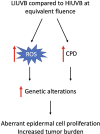Photocarcinogenesis of the skin: Current status and future trends
- PMID: 39907400
- PMCID: PMC11964104
- DOI: 10.1002/kjm2.12946
Photocarcinogenesis of the skin: Current status and future trends
Abstract
Solar radiation is essential for life on Earth but is also a major contributor to skin carcinogenesis. Solar radiation, particularly ultraviolet (UV) B (280-320 nm) and UVA (320-400 nm), induces photocarcinogenesis via various pathways. UV light can directly cause DNA damage, resulting in genetic mutations if not repaired correctly. UV light can also induce photocarcinogenesis by generating reactive oxygen species, inducing immunosuppression and inflammation. Recently, visible light (400-760 nm) has been shown to contribute to photocarcinogenesis by activating oxidative pathways. In addition to the irradiation dose (fluence, J/m2), UVB irradiance (W/m2) is also considered a factor influencing photocarcinogenesis. In this review, we summarize the mechanisms of photocarcinogenesis and provide strategies to prevent skin cancer.
Keywords: skin cancer; ultraviolet radiation; visible light.
© 2025 The Author(s). The Kaohsiung Journal of Medical Sciences published by John Wiley & Sons Australia, Ltd on behalf of Kaohsiung Medical University.
Conflict of interest statement
The authors declare no conflicts of interest.
Figures



Similar articles
-
Current concept of photocarcinogenesis.Photochem Photobiol Sci. 2015 Sep 26;14(9):1713-21. doi: 10.1039/c5pp00185d. Epub 2015 Jul 15. Photochem Photobiol Sci. 2015. PMID: 26177397 Review.
-
The effects of UVB irradiance on vitiligo phototherapy and UVB-induced photocarcinogenesis.Photodermatol Photoimmunol Photomed. 2020 Jul;36(4):257-262. doi: 10.1111/phpp.12536. Epub 2020 Feb 25. Photodermatol Photoimmunol Photomed. 2020. PMID: 32022939 Review.
-
Inflammation, gene mutation and photoimmunosuppression in response to UVR-induced oxidative damage contributes to photocarcinogenesis.Mutat Res. 2005 Apr 1;571(1-2):107-20. doi: 10.1016/j.mrfmmm.2004.09.013. Mutat Res. 2005. PMID: 15748642 Review.
-
Photocarcinogenesis and Skin Cancer Prevention Strategies: An Update.Anticancer Res. 2018 Feb;38(2):1153-1158. doi: 10.21873/anticanres.12334. Anticancer Res. 2018. PMID: 29374752 Review.
-
Toxic effects of ultraviolet radiation on the skin.Toxicol Appl Pharmacol. 2004 Mar 15;195(3):298-308. doi: 10.1016/j.taap.2003.08.019. Toxicol Appl Pharmacol. 2004. PMID: 15020192 Review.
Cited by
-
BTG3-dependent VCP/p97 nuclear translocation is required for efficient repair of UV-induced DNA lesions.Nucleic Acids Res. 2025 Jul 8;53(13):gkaf626. doi: 10.1093/nar/gkaf626. Nucleic Acids Res. 2025. PMID: 40626560 Free PMC article.
-
Skin cancer prevention in the Polish population during the COVID-19 pandemic.Front Public Health. 2025 Jun 20;13:1452043. doi: 10.3389/fpubh.2025.1452043. eCollection 2025. Front Public Health. 2025. PMID: 40620564 Free PMC article.
References
-
- Hansen V. Spectral distribution of solar radiation on clear days: a comparison between measurements and model estimates. J Climate Appl Meteor. 1984;23(5):772–780.
-
- Diffey BL. Ultraviolet radiation and human health. Clin Dermatol. 1998;16(1):83–89. - PubMed
-
- Jussila A, Huotari‐Orava R, Ylianttila L, Partonen T, Snellman E. Narrow‐band ultraviolet B radiation induces the expression of β‐endorphin in human skin in vivo. J Photochem Photobiol B Biol. 2016;155:104–108. - PubMed
-
- Valejo Coelho MM, Matos TR, Apetato M. The dark side of the light: mechanisms of photocarcinogenesis. Clin Dermatol. 2016;34(5):563–570. - PubMed
Publication types
MeSH terms
Substances
LinkOut - more resources
Full Text Sources
Medical

